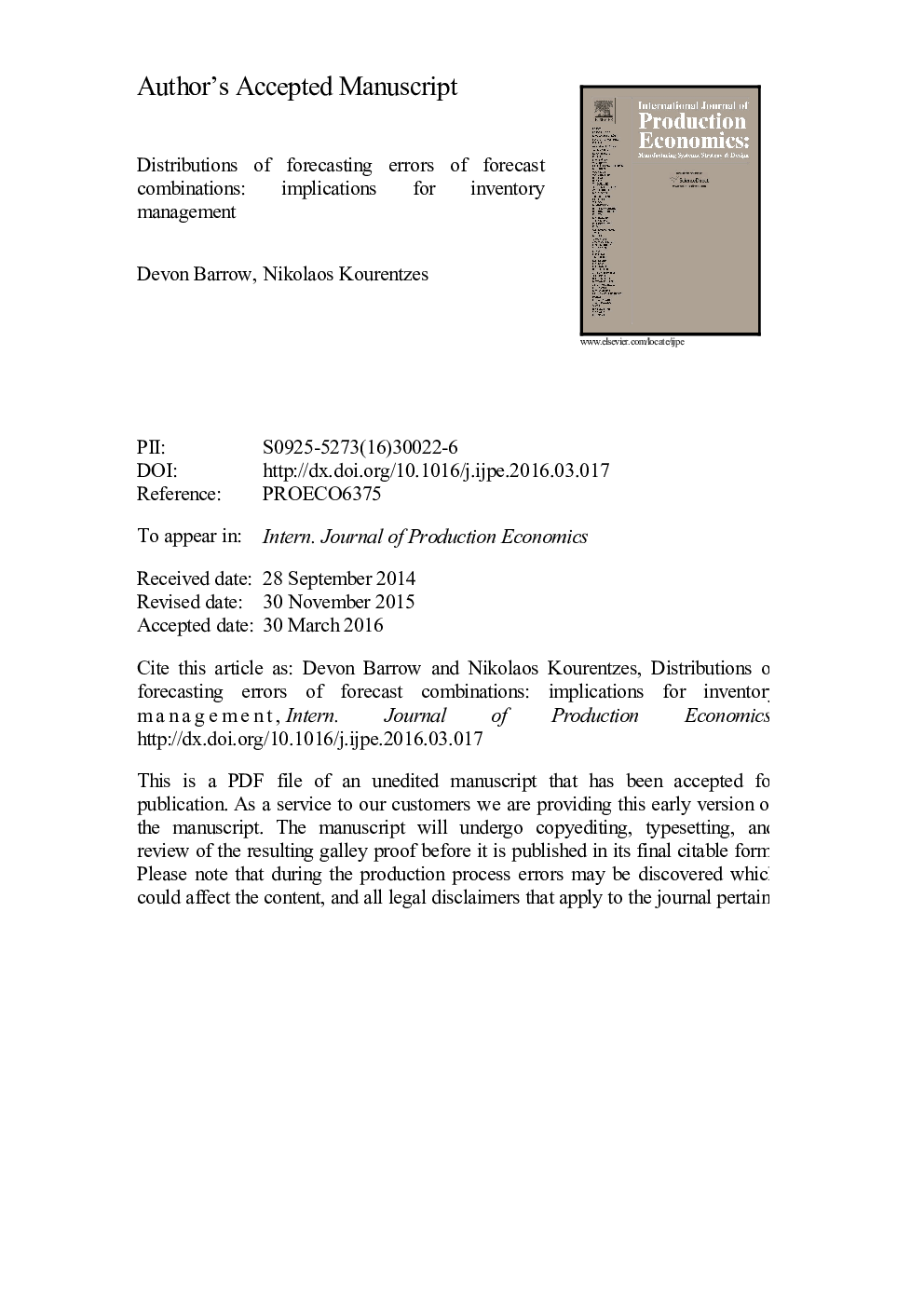| کد مقاله | کد نشریه | سال انتشار | مقاله انگلیسی | نسخه تمام متن |
|---|---|---|---|---|
| 5079278 | 1477530 | 2016 | 40 صفحه PDF | دانلود رایگان |
عنوان انگلیسی مقاله ISI
Distributions of forecasting errors of forecast combinations: Implications for inventory management
ترجمه فارسی عنوان
توزیع خطاهای پیش بینی ترکیبی از پیش بینی: پیامدهای مدیریت موجودی
دانلود مقاله + سفارش ترجمه
دانلود مقاله ISI انگلیسی
رایگان برای ایرانیان
کلمات کلیدی
سری زمانی، پیش بینی، ترکیبی فهرست، سهام ایمنی،
ترجمه چکیده
سیستم های کنترل موجودی به پیش بینی های دقیق و قوی تقاضای آینده متکی هستند تا از تصمیم گیری هایی مانند تنظیم ذخایر ایمنی حمایت کنند. ترکیبی از پیش بینی های چندگانه نه تنها در کاهش خطاهای پیش بینی، بلکه در کاهش حساسیت به محدودیت های یک مدل موثر است. تحقیق در مورد ترکیب پیش بینی عمدتا بر بهبود دقت متمرکز شده است، عمدتا نادیده گرفتن شکل کلی و توزیع خطاهای پیش بینی شده است. با این وجود، این ها برای مدیریت سطح بی توجهی به خطر و عدم اطمینان برای شرکت ها ضروری هستند. این مطالعه توزیع خطای پیش بینی پیش بینی های پایه و ترکیبی و پیامدهای آن برای عملکرد موجودی را بررسی می کند. این تحقیق می کند که آیا ترکیبات پیش بینی توزیع خطای پیش بینی را نسبت به خواسته های مورد نظر برای محاسبات سهام ایمنی، معمولا بر اساس فرض خطاهای توزیع شده و پیش بینی های غیرمستقیم، تغییر می دهند. علاوه بر این، شباهت بین ویژگی های درون و خارج از این خطاها و تأثیر زمان های مختلف زمان را بررسی می کند. اثرات روش های ترکیبی ایجاد شده به طور تجربی با استفاده از یک مجموعه نمایه ای از روش های پیش بینی و مجموعه ای از مجموعه 229 سری تقاضای بارگیری در هفته از یک تولید کننده پیشرو خانگی و مراقبت شخصی بریتانیا، مورد بررسی قرار می گیرد. یافته ها نشان می دهد که ترکیبات پیش بینی، رفتارهای درون و بیرون نمونه را بیشتر سازگار می کنند و به طور متوسط نیاز به کمیته ایمنی کمتر از پیش بینی های پایه دارند. علاوه بر این، ما دریافتیم که استفاده از توزیع خطای تجربی در پیش بینی های ترکیبی در نمونه، به طور معنی داری در مقایسه با پیش بینی های پایه، به طور غیرقابل مقایسه است.
موضوعات مرتبط
مهندسی و علوم پایه
سایر رشته های مهندسی
مهندسی صنعتی و تولید
چکیده انگلیسی
Inventory control systems rely on accurate and robust forecasts of future demand to support decisions such as setting of safety stocks. The combination of multiple forecasts is shown to be effective not only in reducing forecast errors, but also in being less sensitive to limitations of a single model. Research on forecast combination has primarily focused on improving accuracy, largely ignoring the overall shape and distribution of forecast errors. Nonetheless, these are essential for managing the level of aversion to risk and uncertainty for companies. This study examines the forecast error distributions of base and combination forecasts and their implications for inventory performance. It explores whether forecast combinations transform the forecast error distribution towards desired properties for safety stock calculations, typically based on the assumption of normally distributed errors and unbiased forecasts. In addition, it considers the similarity between in- and out-of-sample characteristics of such errors and the impact of different lead times. The effects of established combination methods are explored empirically using a representative set of forecasting methods and a dataset of 229 weekly demand series from a leading household and personal care UK manufacturer. Findings suggest that forecast combinations make the in- and out-of-sample behaviour more consistent, requiring less safety stock on average than base forecasts. Furthermore we find that using in-sample empirical error distributions of combined forecasts approximates well the out-of-sample ones, in contrast to base forecasts.
ناشر
Database: Elsevier - ScienceDirect (ساینس دایرکت)
Journal: International Journal of Production Economics - Volume 177, July 2016, Pages 24-33
Journal: International Journal of Production Economics - Volume 177, July 2016, Pages 24-33
نویسندگان
Devon K. Barrow, Nikolaos Kourentzes,
